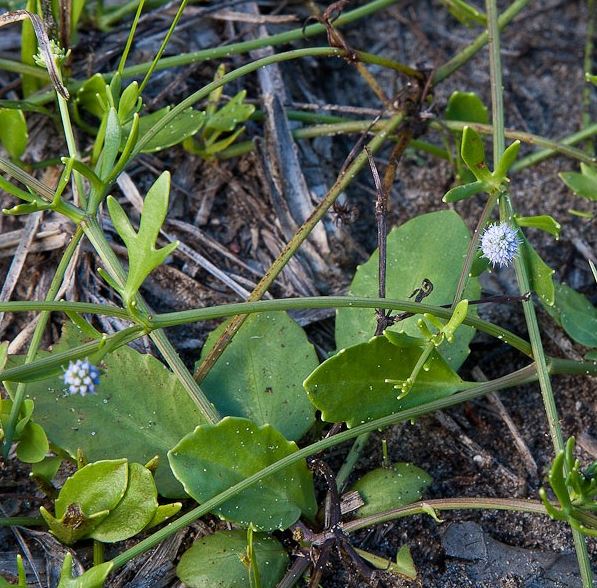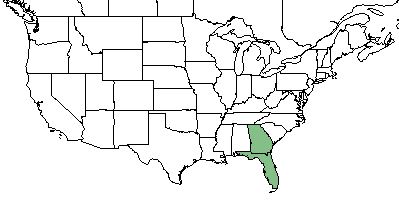Eryngium baldwinii
| Eryngium baldwinii | |
|---|---|

| |
| Photo by John B. of Blue Moon | |
| Scientific classification | |
| Kingdom: | Plantae |
| Division: | Magnoliophyta - Flowering plants |
| Class: | Magnoliopsida - Dicots |
| Order: | Apiales |
| Family: | Apiaceae |
| Genus: | Eryngium |
| Species: | E. baldwinii |
| Binomial name | |
| Eryngium baldwinii Spreng. | |

| |
| Natural range of Eryngium baldwinii from USDA NRCS Plants Database. | |
Common Name: Baldwin's eryngo[1]
Contents
Taxonomic Notes
Synonyms: Eryngium baldwini.[2]
Varieties: none.[2]
Description
Eryngium baldwinii is a dioecious biennial or perennial that grows as a forb/herb.[1] It is aromatic, is low, and creeps along the ground. Leaves are 7 cm long and 2.5 cm wide and can be shaped as ovate, oblong, lanceolate, entire, dentate, cleft or pinnatifid. Flowers are dark to light blue 8 mm long and 4 mm wide.[3] Branches are 1.5-5 dm long and 0.3-1 mm in diameter.[4]
Distribution
This species occurs from southern Georgia and southern Alabama, south to southern Florida.[5]
Ecology
Habitat
E. bladwinii is found in swamps, wet pine flatwoods, fresh to brackish marshes, bogs,[3] ditches,[3][5] pinelands, temporary pools, and other moist to wet sites.[5] This species has been observed in a range of habitats, including muddy bottom of drying ditches, drying lots and other disturbed areas, wet ground in pastures, wet seepage areas, pine flatwoods and pine flatwood clearings, slopes, palm hammocks, swampy woodlands, marshy shores, prairies, and marshes. Soils include drying loamy sand, moist sandy loam, moist peat, moist sandy clay, and moist sandy humus.[6] It is listed by the USDA Natural Resources Conservation Service as a facultative wetland species, where it most often occurs in wetland habitats but can occasionally be found in non-wetland habitats.[1]
Associated species include Gratiola pilosa, Carez reniformis, Lindernia sp., Eleocharis sp., Eryngium prostratum, and Spartina bakeri.[6]
Phenology
In Florida, E. baldwinii has been observed to flower in the spring (April) through fall (October).[3][7][4] This species has also been observed to flower in January, April through July, and November. It has been observed to fruit in January, May through July, and November as well.[6]
Fire ecology
It has been observed in an area that was burned slightly.[6]
Conservation, cultivation, and restoration
Cultural use
Photo Gallery
References and notes
- ↑ 1.0 1.1 1.2 USDA NRCS (2016) The PLANTS Database (http://plants.usda.gov, 01 February 2018). National Plant Data Team, Greensboro, NC 27401-4901 USA.
- ↑ 2.0 2.1 Weakley, A.S. 2015. Flora of the southern and mid-atlantic states. Working Draft of 21 May 2015. University of North Carolina at Chapel Hill, Chapel Hill, North Carolina.
- ↑ 3.0 3.1 3.2 3.3 Tobe JD, Burks KC, Cantrell RW, Garland MA, Sweeley ME, Hall DW, Wallace P, Anglin G, Nelson G, Cooper JR, Bickner D, Gillbert K, Aymond N, Greenwood K, Raymond (1998) Florida Wetland Plants: An Identification Manual. Florida Department of Environmental Protection, Tallhassee, FL
- ↑ 4.0 4.1 Bell CR (1963) The genus Eryngium in the southeastern United States. Castanea 28(3):73-79.
- ↑ 5.0 5.1 5.2 Weakley AS (2015) Flora of the Southern and Mid-Atlantic States. Chapel Hill, NC: University of North Carolina Herbarium.
- ↑ 6.0 6.1 6.2 6.3 Florida State University Robert K. Godfrey Herbarium database. URL: http://herbarium.bio.fsu.edu. Last accessed: May 2019. Collectors: William P. Adams, Loran C. Anderson, L. E. Arnold, Edwin L. Bridges, Richard Carter, Sharon Carter, George R. Cooley, A. H. Curtiss, Chas. C. Deam, R. F. Doren, Elaine Dunkleberger, Paul Fortsch, R. K. Godfrey, S. C. Hood, Richard D. Houlk, Walter Judd, J. M. Kane, Mabel Kral, Robert Kral, William Lindsey, Steve L. Orzell, J. B. Nelson, Grady W. Reinert, J. Sincock, J. K. Small, H. Larry Stripling, Bian Tan, J. N. Triplett, Jr., Kenneth A. Wilson, Carroll E. Wood, Jr., and Jean Wooten. States and Counties: Florida: Alachua, Bradford, Brevard, Charlotte, Citrus, Clay, Collier, Columbia, Dixie, Franklin, Gulf, Hardee, Hernando, Jackson, Lee, Levy, Marion, Nassau, Osceola, Pasco, Polk, Putnam, Sarasota, St Johns, Sumter, Union, and Wakulla. Georgia: Camden, Grady, and Thomas.
- ↑ Nelson, G. PanFlora: Plant data for the eastern United States with emphasis on the Southeastern Coastal Plains, Florida, and the Florida Panhandle. www.gilnelson.com/PanFlora/ Accessed: 1 FEB 2018